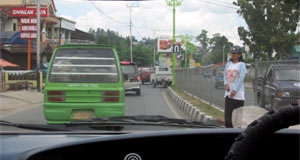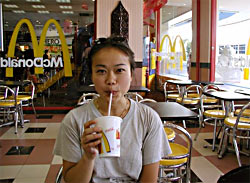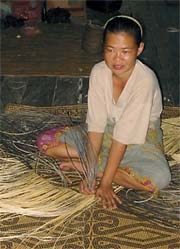 |
Crossing streets can be a death-defying adventure. (Photos by David Hall) |
Risk-taking on the road, comfort at the golden arches, and rattan lessons
Editor's note: Haas MBA students Lindsay Daigle, David Hall, Matilde Kamiya and Toshi Okubo are filing regular dispatches this summer from Borneo, where they are consulting with a farmers' consortium that is trying to turn the region's traditional rattan cultivation into a profitable and sustainable business. The hope is that by keeping more of the earnings from rattan sales at the farmers' level, there will be less incentive to clear-cut the forests in which the rattan grows. The group's first dispatch follows.
Day 1: MondayThe Indonesian morning begins early. The sun rises around 5 a.m., and about the same time, you can hear the call to prayer in the distance. As Dave and Lindsay hadn’t arrived yet, Toshi and Matilde decided to explore the city of Samarinda. We stopped by the hotel lobby and asked for directions downtown. The lady responded, “Here is downtown.”
It was still before 9 a.m., but we could already sense that the day was going to be hot and humid. The roads were busy with cars and motorcycles, but they were oddly lacking in pedestrians – and we quickly discovered why. Crossing streets turned out to be a life-risking event. There are no stoplights and no one stops for you, so you just have to start walking and hope you are still alive when (if!) you reach the other side.
Both sides of the street were filled with mom-and-pop shops. We started to look for food and saw some, but none was approachable, so we kept walking until we ran into a downtown market, where the street was filled with people selling various goods including fruit, livestock, cotton candies and cloths. While we felt people staring, we were surprised that no one approached us to sell anything.
Two hours later under the beating sun, we started to get tired. We were thirsty and hungry. We saw a post office and tried to purchase stamps but were thoroughly unsuccessful. Feeling helpless, we decided to head back to the hotel.
As we tried to make our way back, we spotted a sign advertising the friendly golden arches: “McDonald Central Plaza." Our faces lit up and we started walking, not back to the hotel, but in the direction the sign had pointed. We walked and walked, but no McDonalds. We asked the locals, using hand gestures to imitate the golden arches. Finally we decided to take a cab. The cab was extremely old and so small that even two of us seemed to fill the entire space, making it impossible to believe that it is usually filled with more than five people. Cabbies drive with the door wide open.
 Matilde gets a taste of home at the golden arches. (Photo by Toshi Okubo) |
We gradually saw the scenery, type of shops and road condition change as we left the old city center and entered the more modern and affluent new city center. The central plaza was very similar to one you would see in the United States. It was equipped with Pizza Hut, McDonald's, fancy supermarket, sports shops and game spaces. We had forgotten how bright and reliable the golden arches could look. By using a combination of Indonesian, English and body language, we placed our order, but didn’t end up receiving exactly what we thought we had ordered. Nevertheless, Toshi was happy with his food, repeating over and over again, “I’ve never had such a good cheeseburger.” On the way back to the hotel, he stopped to buy another.
Lindsay and Dave joined the team that evening, just as Matilde and Toshi were returning from their excursion. After a quick “hello” meeting with our client, Ade, we decided to go to a local restaurant, guided by Ade’s recommendation and the mantra of “No more cheeseburgers.” Predictably, all menus were in Indonesian and nobody there was available for translation to English, resulting in plenty of confusion at our table: “Nasi Goreng should be fried rice, so this Goreng means rice!” “No, no, no, that’s to fry!” “This one seems like a special menu, so let’s take it!”
With our very limited knowledge of the Indonesian language but a vivid imagination, five dishes were almost randomly picked. While many people around us no doubt thought we were eccentric, we started to get excited over what we might be getting. Even though some of our guesses were wrong, the food was excellent. We were able to experience eating seafood by hand, as is the local custom. Since that, we’ve enjoyed local restaurants very much. Now, no one is begging for another cheeseburger!
 The team (clockwise from bottom left): Matilde, Lindsay, Toshi and Dave. (Photo by Rahim) |
After a “late” breakfast at 8:30 (people in Samarinda typically get up at 5 a.m.), we met our client Ade to go over the business plan. Ade works for the Consortium for Community-based Forest Management East Kalimantan (SHK-Kaltim), a non-governmental organization (NGO) committed to the environment that gets involved in all sorts of projects to save the Indonesian forest. To this end, SHK has identified rattan farming as a sustainable source of income for the people in East Kalimantan. Rattan is a bamboo-like climbing plant that grows on forest trees. If farmers grow rattan, they won’t cut down the forest to make money on timber. However, the price for rattan is low, and continues to face pressure from the extremely long supply chain the farmers must go through to get their rattan to the end customer (the rattan furniture buyer in Jakarta). Our friend Ade has written a business plan to create a company that will take the farmers’ rattan, pool it, and sell it to the furniture manufacturers, thereby vertically integrating many disjointed functions into one company. He hopes this will allow this company, called SEP, to offer farmers a high enough price to keep them from cutting down the forest.
 Weaving a lampit mat. Learn more about rattan. (Photo by David Hall) |
We spent the better part of the morning learning what rattan was all about, how it is harvested, who the farmers are and how they live. We were also able to see raw rattan and the products it makes, including mats, baskets and furniture. We then moved locations to a much cooler and larger room to hear Ade’s presentation on his business plan. He had made quite a few changes to the plan since we first saw it in February, so we spent the rest of the day sorting them out. We finally wrapped up at about 7:30 p.m. to eat a traditional Indonesian dinner at our hotel with Ade, Yoga (the SHK director involved in the day-to-day operations of the rattan project), and a rattan furniture expert. The furniture expert was very interested in the United States, and we think he learned more about U.S. Chapter 11 bankruptcy procedures than we did about the Indonesian furniture industry. Since Toshi wouldn’t karaoke at the hotel bar for us, we spent time on email at 10 and went to bed shortly thereafter.


